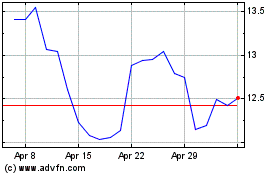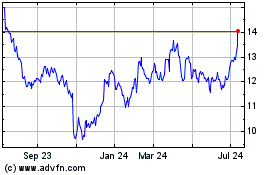By Mike Colias and Anne Steele
A glut of new vehicles are languishing at U.S. dealerships, as
auto makers produce cars at a near-record clip amid softening
demand.
U.S. auto sales slipped 2% in January compared with the same
period a year ago, according to Autodata Corp. The seasonally
adjusted annual sales rate outpaced analyst expectations, but it
was the fourth time in the past six months that volumes slumped
from the prior year despite generous incentives.
The results are forcing Detroit car companies and foreign rivals
to more directly confront a tough strategic decision: Keep
ratcheting up discounts to spur showroom traffic, or lay off
workers so production can more closely mirror underlying
demand.
Both options come with a cost. While incentives move metal, they
cut into margins and threaten to undermine consistent pricing
increases the industry has notched in recent years. Slowing
assembly lines eats up cash because underused factories still
require large amounts of capital to maintain.
Discounts and rebates equaled $3,635 per car on average last
month, according to ALG, far exceeding incentive spending in
January 2016 and representing a 10% discount off the initial asking
price.
ALG, a data provider owned by TrueCar Inc., said average
transaction prices were stronger in January than a year ago --
reflecting brisker sales of expensive trucks -- but prices declined
3% compared with December levels.
North American assembly plants continue building an increasing
amount of stock even as seven years of sales growth are grinding to
a halt, leading to an industrywide inventory average equivalent to
three months' supply, according to a WardsAuto.com estimate.
RBC Capital Markets estimates the industrywide number is nearly
10% higher than what is typical.
The problem is especially acute among the Detroit 3, where
supply exceeds 100 days'. While auto makers typically build
inventory early in the year in advance of the warmer months, many
are complaining that they have far too many sedans and compact
cars, both of which have lost popularity as gasoline prices remain
low.
General Motors Co. had run light on inventory until late last
year and has begun cutting shifts and thousands of jobs at certain
car plants to address the glut. Still, it is boosting truck output
in anticipation of an even stronger appetite for pickups and SUVs
in 2017.
Even with low gasoline prices, GM and others are working harder
to earn truck sales. Chevrolet, GM's mainstream brand, is offering
$7,500 on some popular 2017 Silverado pickups, up from $3,500 last
month, according to a document sent to dealers Wednesday.
Some older 2016 models are being discounted up to $11,000, from
$5,000 in January.
GM's January sales fell 3.8% compared with the same period a
year ago, with 195,909 deliveries representing the lowest volume
for the No. 1 U.S. seller since January 2014. Ford Motor Co.
reported a more modest 0.7% decline, and said it expects a strong
selling season ahead.
"We will continue building inventory into the spring," Mark
LaNeve, Ford's sales chief, said during a Wednesday conference
call.
The Deaborn, Mich., company is trimming some production in the
first quarter regardless of its optimism.
Some analysts argue a cautious approach is needed. "This isn't a
one or two month thing," Mark Wakefield, a co-leader in
AlixPartners LLP's automotive practice, said in an interview.
Mr. Wakefield said that even though some auto makers are taking
steps to curtail supply, it only takes one to offer big bargains
and the rest of the market will follow.
"It's game theory," he said. "It takes one big player."
Much like industry leaders a decade ago, today's auto executives
increasingly are betting on pickup trucks and sport utilities,
which represent more than 60% of light-vehicle sales in the U.S.
That compares with 51% in January 2014, just before sharp declines
in gas prices.
Meanwhile, vehicles such as the Toyota Camry, once a perennial
fixture on the U.S. best-seller list, struggle. Toyota Motor Corp.
reported a 25% decline in demand for its bread-and-butter sedan in
January, and said its smaller RAV4 SUV outsold the Camry.
Executives last month showed off a new version of the car for
2017, saying it should help reinvigorate interest in the stale
segment.
Toyota reported an 11.3% decline in January, blaming the
performance in part on strong December results and a lack of luxury
SUVs.
Honda Motor Co. and Nissan Motor Co. both reported sales
increases of roughly 6%, with both auto makers highlighting truck
offerings, such as the Nissan Titan pickup and the Acura RDX
crossover wagon.
Auto makers are focused more on ramping up truck supply even if
it costs them market share.
Fiat Chrysler Automobiles, for instance, discontinued two
passenger car lines last year and has seen across-the-board correct
sales declines, including an 11.2% swoon in January, as a
result.
Even with the slump, the company is reporting stronger margins
in North America.
"Trucks are the gift that keeps on giving," said Aaron Zeigler,
president of Zeigler Automotive Group.
Mr. Zeigler's group sells at locations in Michigan, Indiana and
Illinois. Fiat Chrysler, including its hot Jeep and Ram brands, are
among the vehicles he sells.
Mr. Zeigler expects auto sales, which topped 17.5 million in
2016, to remain strong. He cites a strong stock market and good
feelings about the economy.
--Anne Steele contributed to this article.
Write to Mike Colias at Mike.Colias@wsj.com and Anne Steele at
Anne.Steele@wsj.com
(END) Dow Jones Newswires
February 01, 2017 17:11 ET (22:11 GMT)
Copyright (c) 2017 Dow Jones & Company, Inc.
Ford Motor (NYSE:F)
Historical Stock Chart
From Mar 2024 to Apr 2024

Ford Motor (NYSE:F)
Historical Stock Chart
From Apr 2023 to Apr 2024
